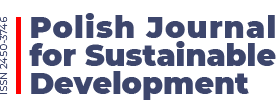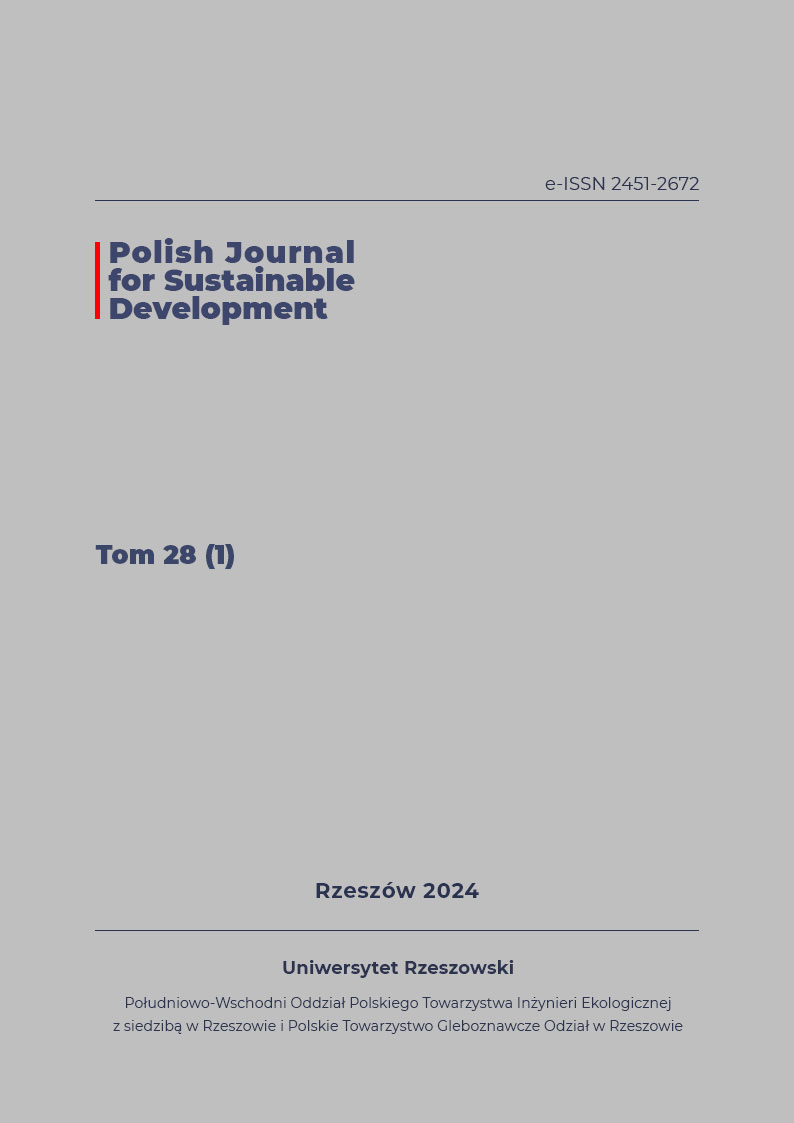Wykorzystanie bezzałogowych statków powietrznych do retardacji przekształcania zasobów środowiska
DOI:
https://doi.org/10.15584/pjsd.2024.28.1.11Słowa kluczowe:
monitoring środowiska, kamery multispektralne i termowizyjne, jakość powietrza, składowiska odpadów komunalnych, instalacje fotowoltaiczne, farmy wiatroweAbstrakt
Gwałtowny postęp techniczny przyczynia się do powstawania narzędzi, które w coraz szerszym zakresie wspierają retardację przekształcania zasobów przyrodniczych. Wielowirnikowe bezzałogowe statki powietrzne (BSP) ze względu na swoją mobilność znajdują zastosowanie w monitoringu, badaniach i ochronie środowiska przyrodniczego. Potencjał wykorzystania BSP wzrasta wraz z dostępnością czujników oraz kamer multispektralnych i termowizyjnych. W artykule omówiono wybrane przykłady zastosowania bezzałogowych statków powietrznych w działaniach mających wpływ na retardację przekształcania zasobów środowiska, w szczególności ich zastosowanie w monitoringu jakości powietrza, składowisk odpadów komunalnych, instalacji energetycznych i pożarów.
Downloads
Bibliografia
Akay S.S., Özcan O., Özcan O., Yetemen Ö. 2024. Efficiency analysis of solar farms by UAV-based thermal monitoring. Eng Sci Technol an Int J. 53. X-Y. doi:10.1016/j.jestch.2024.101688.
Allen G., Pitt J., Hollingsworth P. 2015. Measuring landfill methane emissions using unmanned aerial systems : field trial and operational guidance. [Dokument elektr.: https://www.gov.uk/government/uploads/system/uploads/attachment_data/file/480568/Measuring_landfill_methane_emissions_report.pdf. data wejścia 20.06.2024].
Allison R.S., Johnston J.M., Craig G., Jennings S. 2016. Airborne optical and thermal remote sensing for wildfire detection and monitoring. Sensors. 16(8). 1310. doi:10.3390/s16081310.
Chiliński M.T., Markowicz K.M., Kubicki M. 2018. UAS as a Support for Atmospheric Aerosols Research: Case Study. Pure Appl Geophys. 175(9). 3325-3342. doi:10.1007/s00024-018-1767-3.
Ecke S., Dempewolf J., Frey J., Schwaller A., Endres E., Hans-Joachim Klemmt H-J., Tiede D., Seifert T. 2022. UAV-Based Forest Health Monitoring: A Systematic Review. Remote Sens. 14(13). 3205. doi.org/10.3390/rs14133205.
Filkin T., Sliusar N., Ritzkowski M., Huber-Humer M. 2021. Unmanned aerial vehicles for operational monitoring of landfills. Drones. 5(4). 125. doi:10.3390/drones5040125.
Fosco D., De Molfetta M., Renzulli P., Notarnicola B. 2024. Progress in monitoring methane emissions from landfills using drones: an overview of the last ten years. Sci Total Environ. 945. 173981. doi:10.1016/j.scitotenv.2024.173981.
Larrauri J.I., Sorrosal G., Gonzalez M. 2013 Automatic system for overhead power line inspection using an Unmanned Aerial Vehicle - RELIFO project. 2013 Int Conf Unmanned Aircr Syst ICUAS 2013 - Conf Proc. Published online 244-252. doi:10.1109/ICUAS.2013.6564696.
Li W., Zhao W., Gu J., Fan B., Du Y. 2022. Dynamic characteristics monitoring of large wind turbine blades based on target‐free DSST Vision Algorithm and UAV. Remote Sens. 14(13). 3113. doi:10.3390/rs14133113.
Márquez F.P.G., Ramírez I.S. 2019. Condition monitoring system for solar power plants with radiometric and thermographic sensors embedded in unmanned aerial vehicles. Measurement. 139. 152-162. doi.org/10.1016/j.measurement.2019.02.045.
Matikainen L., Lehtomäki M., Ahokas E., et al. 2016. Remote sensing methods for power line corridor surveys. ISPRS J Photogramm Remote Sens. 119. 10-31. doi:10.1016/j.isprsjprs.2016.04.011.
Michail A., Livera A., Tziolis G., et al. 2024. A comprehensive review of unmanned aerial vehicle-based approaches to support photovoltaic plant diagnosis. Heliyon. 10(1). e23983. doi:10.1016/j.heliyon.2024.e23983.
Oleniacz R., Drzewiecki W., Gorzelnik T. 2023. Assessment of the impact of waste fires on air quality and atmospheric aerosol optical depth: A case study in Poland. Energy Reports. 9. 16-38. doi:10.1016/j.egyr.2023.03.087.
Rohi G., Ejofodomi O., Ofualagba G. 2020. Autonomous monitoring, analysis, and countering of air pollution using environmental drones. Heliyon. 6(1). e03252. doi:10.1016/j.heliyon.2020.e03252.
Sánchez P.B., Ramírez I. S, Márquez F.P.G, Marugán A.P. 2024. Acoustic signals analysis from an innovative UAV inspection system for wind turbines. Struct Heal Monit. 1-14. doi:10.1177/14759217241262970.
Sedano-Cibrián J., de Luis-Ruiz J.M., Pérez-Álvarez R., Pereda-García R., Tapia-Espinoza J.D. 2023. 4D Models Generated with UAV Photogrammetry for Landfill Monitoring Thermal Control of Municipal Solid Waste (MSW) Landfills. Appl Sci. 13(24). 13164. doi:10.3390/app132413164.
Son S.W., Yu J.J, Kim D.W., Park H.S., Yoon J.H. 2021. Applications of Drones for Environmental Monitoring of Pollutant-Emitting Facilities. Pnie. 2(4). 298-304. doi:10.22920/PNIE.2021.2.4.298.
Villa T., Gonzalez F., Miljevic B., Ristovski Z.D., Morawska L. 2016. An overview of small unmanned aerial vehicles for air quality measurements: Present applications and future prospectives. Sensors 16(7). 12-20. doi:10.3390/s16071072.
Pobrania
Opublikowane
Numer
Dział
Licencja
Prawa autorskie (c) 2024 Polish Journal for Sustainable Development

Utwór dostępny jest na licencji Creative Commons Uznanie autorstwa – Użycie niekomercyjne – Bez utworów zależnych 4.0 Międzynarodowe.


